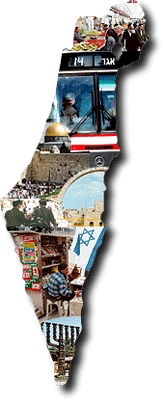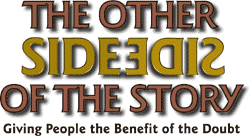Light Lines - Tzav
10 Nissan 5759 / March 27, 1999 Parshat Tzav
The Haggadah that we read at the Pesach Seder refers to four sons: One wise, one wicked, one simple and one who does not know how to ask a question. The sons divide into two pairs - the wise and the simple on one side, and the wicked and the one who does not know how to ask on the other. What connects these two pairs of sons?
The simple son wants to learn. He looks up to the wise son and emulates him. When he hears the wise son asking questions, he also wants to ask. His question 'What's this?' lacks the sophistication of the wise son's question, but it reflects the same sincere desire to learn and understand.
The one who does not know how to ask admires the wicked son. He desires to show the same ironic contempt for the Torah, but unlike the wicked son he lacks the requisite cleverness. Not trusting himself to attack as effectively as his mentor, he remains silent.
The wicked son's 'question' is merely rhetorical - it deserves no response at all. Yet, the one who does not know how to ask is sitting at the table listening to the wicked son's remarks. He's in danger of being influenced. Therefore, our response to the wicked son is really directed to the one who doesn't even know how to ask: "Don't be influenced by his smug cynicism. Had he been in Egypt, he would not have been redeemed. He is cutting himself off from the eternity of the Jewish people."
This difference in approach is described in the book of Proverbs (26:4,5): "Do not answer the fool according to his foolishness, lest you become equal to him. Answer the fool according to his foolishness, lest he be wise in his own eyes." This seems like a contradiction: Should we answer the fool or not?
The answer is that there are two types of fools. One type of fool already 'knows' everything. For him, discussion is merely an opportunity to show off his 'superior' knowledge. There is no point in answering him, because he will never admit a fault. On the contrary, our attempts to educate him will meet with ridicule. As he rejects our insights one after another, the fruitlessness of our efforts makes us appear foolish.
But there is another type of fool: One aware of his limitations. His views are wrong and foolish, but he's not completely closed to instruction. If we open the lines of communication we can have an impact on him. If we don't reach out to him, he'll eventually start to think: "I've held these views for so long, and no one has ever contradicted me - so, I must be right!"
There is a profound message here for our times. We are all confronted with people who scoff at the beauty of Torah. We often have to decide if and how to respond. The book of Proverbs teaches us that our primary responsibility is to improve the critic by our response. If that is impossible, then responding is a waste of time. But if it is possible, then we must not wait for his initiation. We must reach out to him and start the dialogue.
Notice, however, that the wicked son is at the Seder! We do not exclude him or reject him personally. Only discussion with him is avoided, since discussion has no point. The inclusion of the wicked son at the Seder expresses our conviction that no Jew is ever irretrievably lost. We hope our stern response will shake his proud self-confidence to the point where real discussion becomes possible.
Light Insight | Love of the Land | The Other Side of the Story | Response Line | Ohr Somayach Home Page |
 Selections from classical Torah sources which express the special relationship between the People of Israel and Eretz Yisrael Gilgal
Although you will find nothing on the map or in geography books about this place, it was the most important site in the first years of the Nation of Israel in the Land of Israel. Here is where the Israelites under Joshua camped after their miraculous crossing of the Jordan River, and here is where they placed the twelve large stones which they had removed from the river bed to serve as a remembrance for generations of that miracle. The name Gilgal comes from the Hebrew word for "removing." Gilgal became the name for this site because here is where Joshua carried out a mass circumcision for all those who had been born during the forty years in the wilderness, whose climate made such an operation too dangerous. "Today I have removed the shame of Egypt," said G-d, "and the place shall be called Gilgol." This removal of the foreskin which distinguished them from the Egyptians, their former masters, made the entire nation eligible to offer a korban Pesach, the first one in forty years. The Mishkan (Sanctuary), which they Israelites had carried with them throughout their wandering in the wilderness, stood in Gilgol for 14 years, until the Land of Israel was completely taken and divided amongst the tribes, after which it was transferred to Shiloh. |
Light Insight | Love of the Land | The Other Side of the Story | Response Line Ohr Somayach Home Page |
This past Shabbos in Jerusalem, I was walking with some of our children. Talking with one, I didn't notice what happened to my four year old, who suddenly was screaming, crying and holding his head.
I looked back and saw a group of boys watching him come towards me. I asked, "did they hurt you?" He nodded yes. My older son confirmed this. So I immediately yelled at them in Hebrew. They laughed nervously, which got me more upset. Only after I calmed down, and the boys had already run away, did my 6 year old explain that one of the boys had run into my son unintentionally and had even apologized!
I felt terrible about yelling at them, and went back to also apologize, but they were still running, off into the distance, homeward bound.
Light Insight | Love of the Land | Response Line Ohr Somayach Home Page |
Lev Stein wrote:
Dear Rabbi,In studying the Exodus, I can find no timing of the plagues that G-d placed on Egypt. What are the lengths of time that each was placed on the Egyptians, and the time in between each plague. Thanks for your answer.
Dear Lev,
It's generally agreed that 12 months elapsed from the first time Moses stood before Pharaoh until the Jews actually left Egypt.
According to some commentaries, each plague (exept the last) lasted seven days, and there was a 23 day warning period between each plague. Thus, each plague-cycle lasted 30 days. According to others, the plagues lasted 23 days and the warnings lasted seven. Some authorities exclude certain plagues from this scheme, for example, darkness lasted 6 days, other plagues had no warning.
Produced by the Office of Communications
Editor: Raphael Scott Leban
Production: Eliezer Shapiro
Light Insight: Michael Treblow
HTML Production: Eli Ballon
© 1999 Ohr Somayach International - All rights reserved. This publication may be distributed to another person intact without prior permission. We also encourage you to include this material in other publications, such as synagogue newsletters. However, we ask that you contact us beforehand for permission, and then send us a sample issue.
This publication is available via E-Mail
Ohr Somayach Institutions is an international network of Yeshivot and outreach centers, with branches in North America, Europe, South Africa and South America. The Central Campus in Jerusalem provides a full range of educational services for over 685 full-time students.









